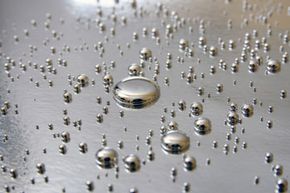Thermometers warn about it, pregnancy diets offer ways around it, and the government has regulations about workplace exposure to it.
Mercury, in its many forms, is not an element to mess with.
Advertisement
In its pure form, mercury is an element -- symbol Hg on the periodic table, metallic, atomic number 80. It's a silvery substance that's liquid at room temperature, and it's naturally occurring. Some estimates put the amount of mercury emissions from natural activities, like volcanic eruptions and the wearing away of rocks, at 2,100 tons annually [source: UDEQ].
While mercury emissions are notoriously difficult to pin down, most sources agree that human activities put more mercury into the atmosphere than natural ones, perhaps 2,900 tons per year [source: UDEQ]. That mercury can come from mining and processing for use in products (like those thermometers) and manufacturing, or from energy-related sources like coal-fired power plants.
Mercury is a neurotoxin, meaning it has detrimental effects on the nervous system. It can damage the brain and lead to physical and emotional disorders. So whether its presence is natural or anthropogenic, it's a potential problem for humans. How big a problem depends on the form of the mercury, how much is present, and which humans are being exposed to it.
While exposure to mercury and its compounds can be devastating, it's not a particularly common occurrence. In this article, we'll find out where mercury is found, how exposure typically happens and what the consequences can be. We'll also see what precautions people can take to reduce their risk of coming into contact with the substance.
The risks associated with mercury exposure vary quite a bit among the general population. One segment experiences vastly greater side effects than any other.
Advertisement




